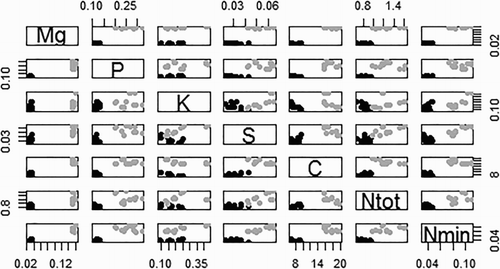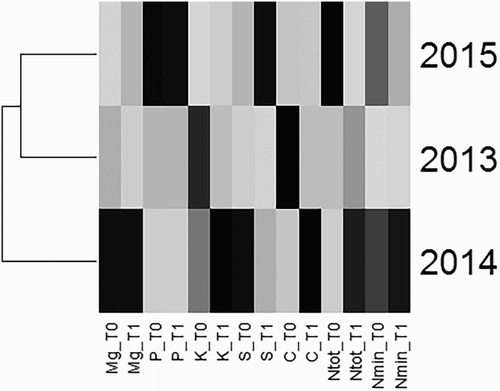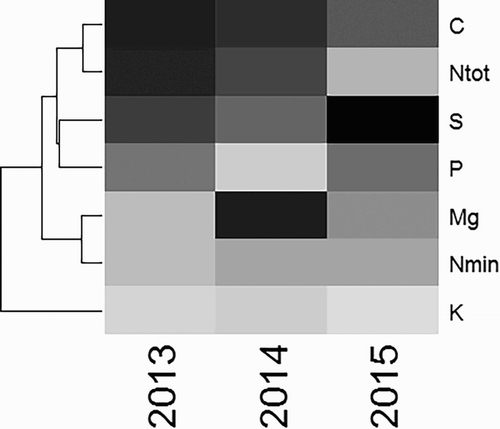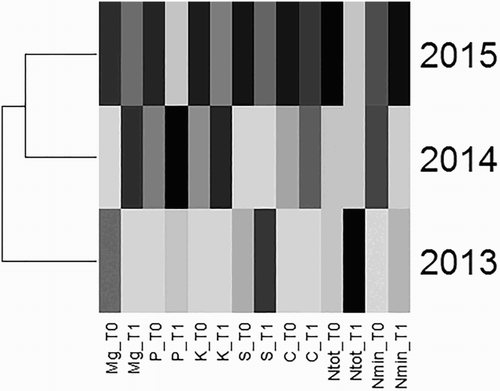Figures & data
Table 1. Basic chemical composition of sewage sludge compost and soils used in the experiment (g·kg−1).
Figure 1. Contents of nutrients in light (black dots) and in medium soil (grey dots) presented in pairs (contents of Mg and P, contents of Mg and K, contents of Mg and S, … , contents of Ntot and Nmin). The dots concentrated in the bottom left corner (black) on each chart show small amounts of element (corresponding to light soil), and the dots concentrated in the top right corner (grey) show larger amounts of element (corresponding to medium soil).

Table 2. The p-values of the results of seven independent analyses of variance (seven nutrients) for two type of soils (light soil and medium soil).
Figure 2. Dendrogram. Grouping of years (2013, 2014, 2015) with respect of the average values of the increments or losses of nutrient amounts found in light soil amended with sewage sludge compost (T1 – dose 0.2 kg of compost /pot) and control soil (T0 – dose 0 kg of compost /pot). Dark colour – large increase in the content of elements in the soil, light colour – decrease in the content of elements. The years 2013 and 2015 are slightly similar in respect of average increase or decrease in content (nutrients) in the soil.

Figure 3. Dendrogram. Grouping of elements with respect to average increments or losses of the amounts of nutrients across all three years (2013, 2014, 2015) in light soil amended with sewage sludge compost (dose 0.2 kg of compost /pot). Dark colour – large increase in the content of elements in the soil, light colour – decrease in the content of elements. The nutrients C and Ntot are similar in respect of average increase or decrease in content, Mg and Nmin are similar, and S and P are slightly similar in respect of average increase or decrease in content.

Table 3. The p-values of two-way analysis of variance for comparisons of increments of analysed nutrient amounts (compared nutrients: C, Ntot, Nmin, P, K, Mg and S) for two type of soils (light soil and medium soil) in the years of the studies (2013, 2014, 2015) and their interactions (Nutrient × year).
Table 4. The homogeneous groups of nutrients with respect of increments their amounts in Tukey test for two type of soils (light soil and medium soil) on average over the years of studies. (groups a, ab, abc are homogeneous; and groups a, b, c, d are separable).
Figure 4. Dendrogram. Grouping of years (2013, 2014, 2015) with respect of the average values of the increments or losses of nutrient amounts found in medium soil amended with sewage sludge compost (T1 – dose 0.2 kg of compost /pot) and control soil (T0 – dose 0 kg of compost /pot). Dark colour – large increase in the content of elements in the soil, light colour – decrease in the content of elements. The years 2014 and 2015 are slightly similar in respect of average increase or decrease in content of elements (nutrients) in the soil.

Figure 5. Dendrogram. Grouping of elements with respect to average increases or losses of the amounts of nutrients across all three years (2013, 2014, 2015) in medium soil amended with sewage sludge compost (dose 0.2 kg of compost /pot). Dark colour – large increase in the content of elements in the soil, light colour – decrease in the content of elements. The nutrients C and Mg are similar in respect of average increase or decrease in content, Nmin and S are similar in respect of average increase or decrease in content.

